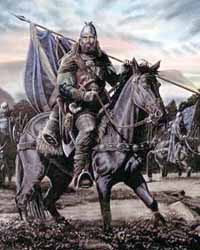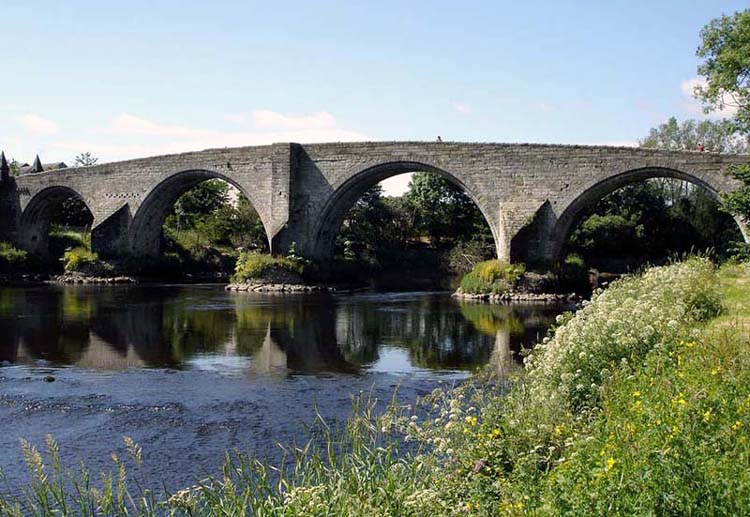
The march on Stirling Bridge
Clan Moray & Murray
Famed for their patriotism from earliest times they boasted a royal origin. They are descended from the Flemish nobleman Freskin de Moravia (also progenitor of Clan Sutherland). Flemish and Norman lords crossed the North Sea and established themselves in the Scottish realm at the invitation of the Kings of Scots from the early 12th century. Freskin and his son were granted extensive lands in Moray and intermarried with the old line of Celtic Mormaers from Moray. They took the name 'de Moravia', ie. 'of Moray' in Latin. The descendents of his grandson William de Moravia's descendents became Lords of Bothwell. The name became more generally written simply as 'Moray' (or variants), deriving from the great province of Moray, once a local kingdom, by the end of the 13th century. From him descend the principal houses of Murray; Tullibardine, Atholl, Abercairney and Polmaise. The name Murray is believed to derive from Pictish Moritreb, meaning 'seaward settlement', referring to the ancient province, the Mormaer of Moray much larger than the present county of Moray, running along the coast of the Moray Firth, north of the Grampians. MacMurray, Moray, Murry and Morogh are all variants of the family name. ..... more
- A1. Freskin de Moravia;
<==> Clan Sutherland
- B1. William de Moravia;
- C1. William de Moravia, m. N. de Olifard;
- D1. N. de Moravia;
- E1. N. de Moravia;
- F1. Sir Malcolm de Moravia, Sheriff of Perthshire;
- G1. Sir William de Moravia;
- H1. Sir Andrew Murray of Tullibardine, d:1332;
- I1. Sir William Murray of Tullibardine;
- J1. Sir John Murray of Tullibardine;
- K1. Walter Murray, d:1390, m. Margaret le Baird;
- L1. Sir David Murray, m. Isabel Stewart;
==> Clan Stewart
- M1. Sir David Murray, d:1452, m. Margaret Colquhoun;
==> Clan Colquhoun
- J1. Marion Moray, m. Sir Malcolm Drummond; <== Clan Drummond
- M1. Sir David Murray, d:1452, m. Margaret Colquhoun;
==> Clan Colquhoun
- L1. Sir David Murray, m. Isabel Stewart;
==> Clan Stewart
- K1. Walter Murray, d:1390, m. Margaret le Baird;
- J1. Sir John Murray of Tullibardine;
- I1. Sir William Murray of Tullibardine;
- H1. Sir Andrew Murray of Tullibardine, d:1332;
- G1. Sir William de Moravia;
- F1. Sir Malcolm de Moravia, Sheriff of Perthshire;
- E1. N. de Moravia;
- D2. Sir Walter de Moravia, d:1244, m. Christian Lascelles;
- E1. William de Moravia of Petyn, m. N. of Fife;
==> Earls of Fife
- F1. Walter de Moravia of Bothwell;
- G1. Sir Andrew de Moray of Bothwell, d:1289, m1. N. Comyn, m2. Euphemia de Clavering;
- H1. [m1]: Sir Andrew de Moray of Bothwell, d:1297 Stirling Bridge;
- I1. Sir Andrew Moray, Regant, lvd:1298/1338, m. Christina Bruce;
==> Clan Bruce
- J1. Margaret Moray, lvd:1364, m. Sir William Fraser; <== Clan Fraser
- I1. Sir Andrew Moray, Regant, lvd:1298/1338, m. Christina Bruce;
==> Clan Bruce
- H1. [m2]: Sir William de Moray, 1st of Drumsagard, lvd:1289;
- I1. Sir John Moray, 2nd of Drumsagard;
- J1. Sir Maurice Moray, Earl of Strathearn, d:1346 Neville's Cross, m. Joanna Mentieth;
- K1. Joanna Moray, m. Archibald Douglas; <== Clan Douglas
- J1. Sir Maurice Moray, Earl of Strathearn, d:1346 Neville's Cross, m. Joanna Mentieth;
- I1. Sir John Moray, 2nd of Drumsagard;
- H1. [m1]: Sir Andrew de Moray of Bothwell, d:1297 Stirling Bridge;
- G1. Sir Andrew de Moray of Bothwell, d:1289, m1. N. Comyn, m2. Euphemia de Clavering;
- F1. Walter de Moravia of Bothwell;
- E1. William de Moravia of Petyn, m. N. of Fife;
==> Earls of Fife
- D1. N. de Moravia;
- C1. William de Moravia, m. N. de Olifard;
- B1. William de Moravia;
